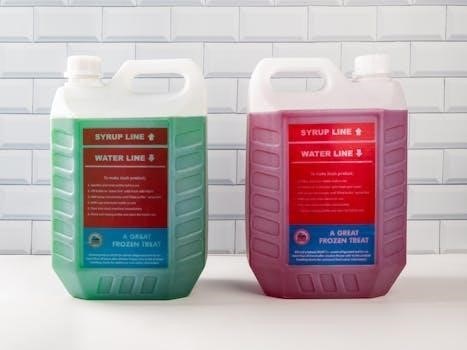
hi yield 2 4 d mixing instructions
Hi-Yield 2,4-D Mixing Instructions⁚ An Overview
Hi-Yield 2,4-D is a selective herbicide effective against broadleaf weeds. Proper mixing is essential for efficacy and safety. This guide will provide instructions for various applications including lawns, pastures, and spot treatments. Always refer to the product label for specific details. The concentration of the active ingredient may vary by brand.
Understanding 2,4-D Concentration and Formulation
The effectiveness of Hi-Yield 2,4-D depends heavily on understanding its concentration and formulation. 2,4-Dichlorophenoxyacetic acid, or 2,4-D, is a post-emergent herbicide that targets broadleaf weeds. It is available in various concentrations, and this impacts how much product you need for dilution. Different manufacturers produce 2,4-D with varying potencies; therefore, it’s crucial to examine the product label before mixing. The physical form of the herbicide—whether it’s a liquid, dust, or granules—also influences how it should be handled and mixed. The formulation can affect its absorption by plants, and its stability in water. Amine formulations are common, and these are generally considered safer than ester formulations. This is because they are less volatile. Be sure to take into account the environmental consequences when using 2,4-D, as misuse can harm non-target plants. Always follow mixing and application instructions carefully as they are directly linked to the product’s safety and efficacy. The correct concentration ensures weeds are controlled while preventing damage to desired vegetation.
General Mixing Ratio for Hi-Yield 2,4-D
The general mixing ratio for Hi-Yield 2,4-D is crucial for effective weed control and to prevent harm to desirable plants. As a general guideline, a common recommendation is to mix 5 ounces of Hi-Yield 2,4-D per gallon of water. This ratio is often cited for broad applications, however, it’s always best to confirm the specific instructions on the product label, as concentrations can vary. This general ratio can be adjusted based on the specific application. For instance, when dealing with particularly stubborn or mature weeds, you might need to increase the concentration slightly, however, caution is advised. Remember that over-application can be more harmful than using a weaker mixture. For smaller areas or spot treatments, adjust the ratio proportionally to avoid waste. Always use clean water and a properly calibrated sprayer to ensure even application. This method allows for effective coverage and minimizes the risk of over application. Consistent adherence to the product label is key to successful weed control.
Spot Treatment Mixing Instructions
For spot treatments using Hi-Yield 2,4-D, a more concentrated solution is often employed, allowing for precise application to individual weeds or small patches. A common recommendation is to mix 1.25 ounces (approximately 2.5 tablespoons) of Hi-Yield 2,4-D in a 32-ounce chemical-resistant spray bottle. This mixture is suitable for targeting weeds in lawns, gardens, or along concrete seams. This ratio is designed for focused application, ensuring you’re targeting weeds directly without over saturating the surrounding areas. Always ensure the spray bottle is chemical resistant and is thoroughly cleaned after use to avoid any contamination. When using this method, be sure to apply the mixture directly to the leaves of the weeds, avoiding excessive runoff. It is important to note that this concentrated mix should only be used for spot treatments and not for broader application. Consistent adherence to the product label will ensure optimal results. Avoid spraying on windy days.
Mixing for Pastures and Rangeland
When applying Hi-Yield 2,4-D to pastures and rangeland, the mixing ratio is slightly different from spot treatments. It’s generally recommended to use 3 to 4 fluid ounces of Hi-Yield 2,4-D per 1 to 3 gallons of water for every 1,000 square feet. This diluted solution is designed to cover a larger area, making it suitable for broader application on grazing lands. The exact amount of water used within this range can depend on the density of the weeds and the type of sprayer you are using. For dense weed infestations, you might opt for the lower end of the water range, using 1 gallon per 1000 sq ft, while for lighter infestations, 3 gallons may suffice. It’s very important to distribute the solution evenly to ensure effective weed control. Always refer to the product label for the most accurate mixing ratios and application guidelines. Over application can be harmful to grass.

2,4-D Application Rate Per Square Foot
When using Hi-Yield 2,4-D, achieving the correct application rate per square foot is crucial for effective weed control and to prevent damage to desired plants. The general guideline for application is to use a solution mixed at a rate that covers 1,000 square feet with 1 gallon of the diluted herbicide. For example, if using the recommended rate of 5 ounces of 2,4-D per gallon, this 1 gallon solution should ideally treat 1,000 square feet of lawn or pasture. It’s important to note that this is an average, and the precise amount needed may vary slightly based on weed density and application technique. If you are doing a spot treatment, the rate of coverage is dependent on the size of the area you are spraying. Avoid over application by ensuring you do not apply more than one gallon of diluted solution per 1,000 sq ft. Always refer to the product label for the most accurate instructions.
Mixing 2,4-D for a 25-Gallon Sprayer
For larger applications using a 25-gallon sprayer, precise mixing of Hi-Yield 2,4-D is essential for effective weed control. A general guideline to follow is to use approximately 32 ounces of 2,4-D concentrate for a full 25-gallon tank of water. This concentration is suitable for most applications, but adjustments may be needed based on the size and type of weeds you’re targeting. If you are dealing with smaller or less dense weeds, you might reduce the amount of 2,4-D to 25 ounces. Always start with the lower end of the recommended range. Also, ensure even distribution of the mixture while spraying. Correctly mixing 2,4-D is important to prevent damage to your lawn. Be sure to follow the directions provided on the product label for best results. It’s important to consider using natural herbicides as an alternative for safer options.
Using Surfactants with 2,4-D
Enhancing the effectiveness of Hi-Yield 2,4-D often requires the addition of a surfactant. Surfactants are compounds that help the herbicide adhere to plant leaves, ensuring better absorption and reducing runoff. This is particularly crucial when dealing with waxy or hairy leaves, which can repel water-based solutions. Commercial surfactants are readily available and come with specific mixing instructions. A common alternative is to use household dish soap, with about one tablespoon per gallon of water. When mixing, always add the 2,4-D and the surfactant to the sprayer before adding water. This process allows for a proper combination of ingredients. Surfactants help the herbicide stick to the plant, boosting its effectiveness. The use of a surfactant can make a significant difference in weed control and reduces the possibility of the herbicide washing away before it can be effective.
Potential Damage From Overapplication
While Hi-Yield 2,4-D is designed to target broadleaf weeds without harming grass, overapplication can cause significant damage. Applying too much of the herbicide, or applying it to an area at a higher concentration than recommended, can injure or even kill your lawn. Signs of overapplication can include yellowing, browning, and stunted growth of the grass. It is crucial to adhere strictly to the manufacturer’s recommended dilution rates and application areas. Applying too strong of a mix won’t kill more weeds; it will overload your yard and harm it. Always calculate the square footage of the area you are treating and mix accordingly. If you spray 2,4-D at a rate of 1 gallon per 500 feet, you will have applied double the recommended amount of 2,4-D for that area. This can and will harm your grass. Conversely, applying the solution too thinly can result in poor weed control, as the herbicide may not be present in high enough concentrations to kill the weeds. Therefore, controlled application is key. Avoid damage to your lawn by properly mixing liquid concentrate 2,4-D in the appropriate number of gallons of water.

Mixing in Handheld or Backpack Sprayers

When using a handheld or backpack sprayer for Hi-Yield 2,4-D application, it’s crucial to follow specific mixing guidelines to ensure effective weed control without harming desirable plants. For general use, a standard recommendation is to mix 5 ounces of Hi-Yield 2,4-D concentrate per gallon of water. This ratio is designed to be strong enough to eliminate broadleaf weeds while minimizing the risk of damage to your lawn. Always ensure you are using a clean sprayer to prevent contamination. Before adding the water, pour the 2,4-D concentrate into the sprayer. This is followed by adding the correct amount of water. Always review the product label for any specific instructions or variations based on your needs. Different vendors sell different potencies of 2,4-D, so it is important to review the label. Ensure that the mixture is thoroughly combined before application. If using a surfactant, add it before the water. This will enhance the herbicide’s effectiveness by helping it stick to the leaves. Always measure carefully and avoid over or under-diluting the mixture. Proper mixing is vital for successful weed control and the health of your lawn.

Hose-End Sprayer Instructions
Using a hose-end sprayer for applying Hi-Yield 2,4-D requires careful attention to detail to ensure proper dilution and application; The key to success is understanding the specific operation of your hose-end sprayer, as models can vary. Whether you have a fixed-rate sprayer or a metering sprayer, both control how much 2,4-D mixes with the water flow. Before use, familiarize yourself with the sprayer’s instructions. For Hi-Yield 2,4-D, the general recommendation is a mix rate equivalent to 5 ounces of 2,4-D per gallon of water. However, you will not be mixing it directly in the sprayer. Instead, you will need to adjust the dial on the hose-end sprayer to dispense the appropriate amount of the product into the water stream. Fill the reservoir of your hose-end sprayer with the concentrate. Set the dial on the sprayer to the manufacturer-recommended setting for 2,4-D or a similar product. Ensure that the connection between the sprayer and hose is secure to prevent leaks. Apply the mixture evenly across the desired area, making sure not to over-saturate any single spot. Proper use of the hose-end sprayer will help in effective weed control. Always review the product label.
Mixing 2,4-D for Spot Treatments in Spray Bottles
For targeted weed control, mixing Hi-Yield 2,4-D in a spray bottle is a convenient method for spot treatments. This approach is especially useful for weeds in lawns, gardens, or along concrete edges. To prepare the solution, you’ll need a chemical-resistant spray bottle and the correct ratio of 2,4-D to water. A general guideline is to mix 1.25 ounces (or 2.5 tablespoons) of Hi-Yield 2,4-D into a 32-ounce spray bottle. This mixture is typically sufficient to cover approximately 250 square feet. Ensure that you measure the 2,4-D accurately using measuring spoons or a graduated cylinder to avoid over-concentration. Once you have measured the concentrate, carefully pour it into the spray bottle. Next, fill the remaining space in the bottle with water. Secure the spray bottle lid tightly and shake gently to ensure that the 2,4-D is evenly distributed throughout the solution. Avoid overmixing, which could cause foaming. Now, the spray bottle is ready for application. Apply the solution directly to the weeds, avoiding overspray onto desirable plants. Remember to use personal protective equipment while mixing and applying, such as gloves and eye protection.